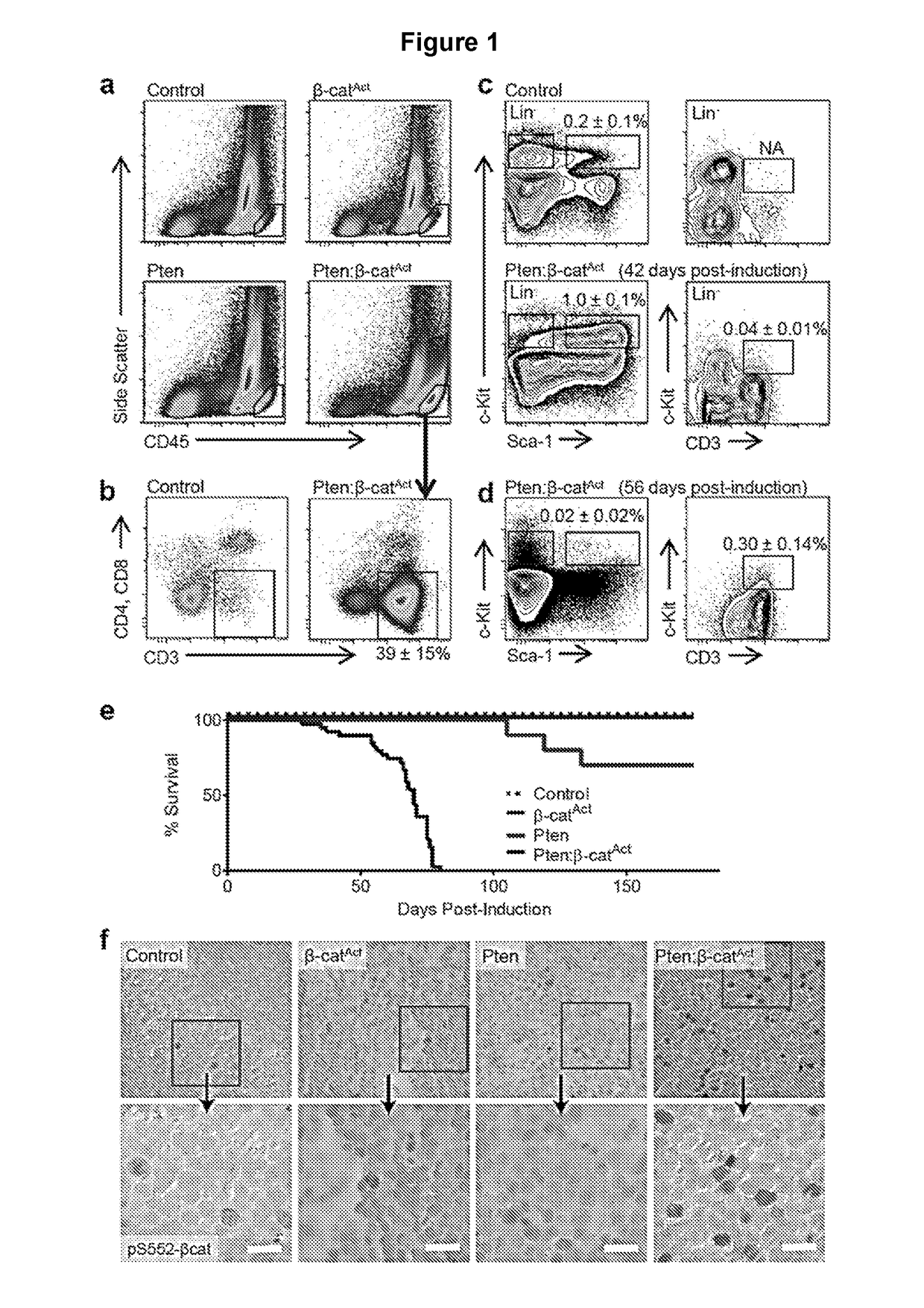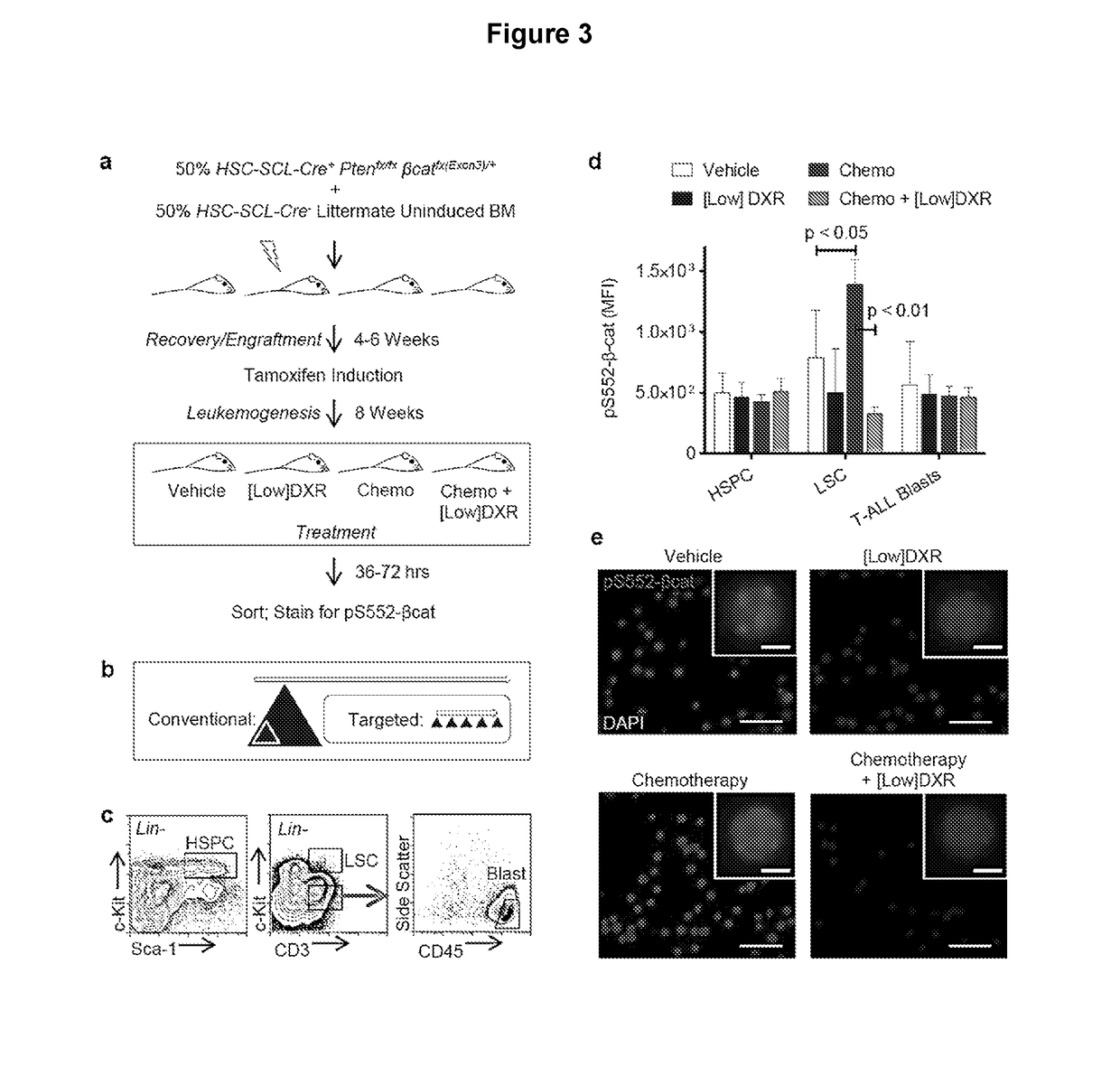Methods for treating chemoresistant cancer-initiating cells
a technology of chemoresistant cancer and initiating cells, which is applied in the field of cancer treatment, can solve the problems of leukemic transformation and expansion of untransformed stem cells, and achieve the effects of broad and effective anti-cancer activity, reduced ps552--catenin levels, and minimal effect on total -catenin
- Summary
- Abstract
- Description
- Claims
- Application Information
AI Technical Summary
Benefits of technology
Problems solved by technology
Method used
Image
Examples
example 1
Simultaneous Activation of Wnt / β-Catenin and PI3K / Akt Pathways Results in Successive Expansion of HSPCs, LSCs and T-ALL Blast Cells
[0113]Previous work showed that cooperative activation of the Wnt / β-catenin and PI3K / Akt pathways drove self-renewal but resulted in leukemic transformation. The ontogeny and nature of leukemogenesis in Pten:β-catAct mice that activate both pathways in HSPCs was explored. Pten:β-catAct double mutants consistently and robustly developed blast crisis as indicated by >20% CD45hi leukemic blasts. These cells were negative for major lineage markers but expressed CD3 while being negative for CD4 and CD8, suggesting a maturation blockage in early T-cell development (FIG. 1a-b). Analysis of major lineages from BM, spleen, and thymus showed a reduction in mature lineages with a large increase in immature (double negative) thymocytes in the thymus and with CD3+ blasts overtaking the BM compartment by 9-10 weeks post-induction (wpi) (FIG. 6). To trace the ontogeny ...
example 2
DXR Targets pS552-β-Catenin while Sparing Total β-Catenin
[0114]Since pharmacological activation of the Wnt / β-catenin and PI3K / Akt pathways in normal HSCs synergistically drives self-renewal and expansion, it was tested whether inhibition of this cooperation could prevent oncogenic self-renewal. While there was some success in reducing LSCs using a novel pan-β-catenin inhibitor, the focus was on inhibiting the pS552-β-catenin active form of β-catenin to target the cooperative activity of the pathways more specifically and to have lower toxicity than a pan-β-catenin inhibitor (FIG. 8). High-throughput screening (HTS) identified several candidates for this specific inhibition (FIG. 2a), which was narrowed to 3 compounds based on their ability to inhibit pS552-β-catenin with less effect on pan β-catenin: DXR, 0105375, and thioguanosine (FIG. 2b-c). Interestingly, DXR and thioguanosine are known anti-cancer agents, with DXR being among the most successful anti-cancer therapies and thiogu...
example 3
Low-Dose DXR Treatment Inhibits the High Level of pS552-β-Catenin Uniquely Overexpressed in Chemoresistant LSCs
[0117]It was next determined whether DXR could inhibit pS552-β-catenin in vivo. To obtain a relatively large set of leukemic mice that could be consistently used at the same stage after induction to test different treatment regimens, whole BM from uninduced Pten:β-catAct mice was transplanted into irradiated recipients. This was combined at a 1:1 ratio with Cre negative BM from littermates to allow for potential competition between normal and leukemic cells and to more closely reflect clinical circumstances. After 4-6 weeks for recovery and engraftment, mice were placed on tamoxifen feed to induce recombination. After 8 weeks, leukemia was established in all recipients, which then received various treatments (FIG. 3a).
[0118]To repurpose DXR as a targeted inhibitor of pS552-β-catenin rather than a cytotoxic chemotherapeutic drug, doses well below the typical clinical dose we...
PUM
| Property | Measurement | Unit |
|---|---|---|
| molecular weight | aaaaa | aaaaa |
| molecular weight | aaaaa | aaaaa |
| size | aaaaa | aaaaa |
Abstract
Description
Claims
Application Information
 Login to View More
Login to View More - R&D
- Intellectual Property
- Life Sciences
- Materials
- Tech Scout
- Unparalleled Data Quality
- Higher Quality Content
- 60% Fewer Hallucinations
Browse by: Latest US Patents, China's latest patents, Technical Efficacy Thesaurus, Application Domain, Technology Topic, Popular Technical Reports.
© 2025 PatSnap. All rights reserved.Legal|Privacy policy|Modern Slavery Act Transparency Statement|Sitemap|About US| Contact US: help@patsnap.com



